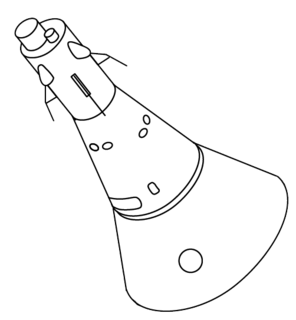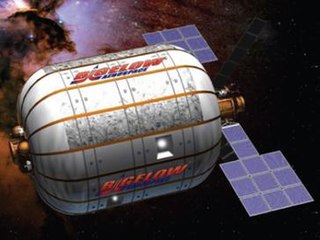
Soyuz is a series of spacecraft which has been in service since the 1960s, having made more than 140 flights. It was designed for the Soviet space program by the Korolev Design Bureau. The Soyuz succeeded the Voskhod spacecraft and was originally built as part of the Soviet crewed lunar programs. It is launched on a Soyuz rocket from the Baikonur Cosmodrome in Kazakhstan. Between the 2011 retirement of the Space Shuttle and the 2020 demo flight of SpaceX Crew Dragon, the Soyuz served as the only means to ferry crew to or from the International Space Station, for which it remains heavily used. Although China did launch crewed Shenzhou flights during this time, none of them docked with the ISS.
Human spaceflight programs have been conducted, started, or planned by multiple countries and companies. Until the 21st century, human spaceflight programs were sponsored exclusively by governments, through either the military or civilian space agencies. With the launch of the privately funded SpaceShipOne in 2004, a new category of human spaceflight programs – commercial human spaceflight – arrived. As of July 2021, three countries and one private company (SpaceX) have launched humans to Earth orbit, and two private companies have launched humans on a suborbital trajectory. The criteria for what constitutes human spaceflight vary. The Fédération Aéronautique Internationale defines spaceflight as any flight over 100 kilometers (62 mi). In the United States professional, military, and commercial astronauts who travel above an altitude of 80 kilometers (50 mi) are awarded the United States Astronaut Badge. This article follows the FAI definition of spaceflight.

TransHab was a concept pursued by NASA in the 1990s to develop the technology for expandable habitats inflated by air in space. Specifically, TransHab was intended as a replacement for the already existing rigid International Space Station crew Habitation Module. When deflated, inflatable modules provide an 'easier to launch' compact form. When fully inflated, TransHab would expand to 8.2 meters in diameter.
Bigelow Aerospace is an American aeronautics and outer space technology company which manufactures and develops expandable space station modules. Bigelow Aerospace was founded by Robert Bigelow in 1998, and is based in North Las Vegas, Nevada. It is funded in large part by the profit Bigelow gained through his ownership of the hotel chain, Budget Suites of America.

America's Space Prize was a US$50 million space competition in orbital spaceflight established and funded in 2004 by hotel entrepreneur Robert Bigelow. The prize would have been awarded to the first US-based privately funded team to design and build a reusable manned capsule capable of flying 5 astronauts to a Bigelow Aerospace inflatable space module. The criteria also required the capsule be recovered and flown again in 60 days. The prize expired January 10, 2010, without a winner or any test flights attempted. The teams were required to have been based in the United States.

A space capsule is an often-crewed spacecraft that uses a blunt-body reentry capsule to reenter the Earth's atmosphere without wings. Capsules are distinguished from satellites primarily by the ability to survive reentry and return a payload to the Earth's surface from orbit. Capsule-based crewed spacecraft such as Soyuz or Orion are often supported by a service or adapter module, and sometimes augmented with an extra module for extended space operations. Capsules make up the majority of crewed spacecraft designs, although one crewed spaceplane, the Space Shuttle, has flown in orbit.

The Vozvraschaemyi Apparat, or VA spacecraft, was a Soviet crew capsule, intended to serve as a crewed launch and reentry vehicle. Initially designed for the LK-1 human lunar flyby spacecraft for one of the Soviet crewed lunar programs, then the LK-700 redesign, it was later repurposed for the Almaz military space station program. The VA capsule on display at the Smithsonian National Air and Space Museum was labeled as Merkur, following a mistranslation of the original documentation – while incorrect, the name is being used in the West for the VA spacecraft and capsule.

The B330 was an inflatable space habitat being privately developed by Bigelow Aerospace from 2010 until 2020. The design was evolved from NASA's TransHab habitat concept. B330 will have 330 cubic meters (12,000 cu ft) of internal volume, hence its numeric designation.

Genesis I is an experimental space habitat designed and built by the private American firm Bigelow Aerospace and launched in 2006. It was the first module to be sent into orbit by the company, and tested various systems, materials and techniques related to determining the viability of long-term inflatable space structures through 2008. Such structures, including this module and others built by Bigelow Aerospace, were similar to the 1990s NASA expandable TransHab design, which aimed to provide increased interior volume at a reduced launch diameter and potentially reduced mass compared to traditional rigid structures.

Genesis II is the second experimental space habitat designed and built by the private American firm Bigelow Aerospace, launched in 2007. As the second module sent into orbit by the company, this spacecraft builds on the data and experience gleaned from its previously orbited sister-ship Genesis I. Like its sister-ship and other modules being designed by Bigelow Aerospace, this spacecraft is based on the NASA TransHab design, which provides increased interior volume and reduced launch diameter along with potentially reduced mass compared to traditional rigid structures.

Sundancer was the proposed third prototype space habitat intended to be launched by Bigelow Aerospace—and the first human-rated expandable module based on TransHab technology acquired from NASA. It was to have been used to test and confirm systems used in the company's commercial space station efforts during the early 2010s, and if successful, would have formed the first piece of the proposed commercial space station.

Inflatable habitats or expandable habitats are pressurized tent-like structures capable of supporting life in outer space whose internal volume increases after launch. They have frequently been proposed for use in space applications to provide a greater volume of living space for a given mass.

The Functional Cargo Block or FGB was part of the Soviet TKS spacecraft. The TKS spacecraft was intended to be used as a resupply craft for Almaz space stations and saw some test flights in the Salyut space station program. The TKS spacecraft was formed by mating a FGB with a VA spacecraft, with both the VA and the FGB being capable of independent operation.

Space architecture is the theory and practice of designing and building inhabited environments in outer space. This mission statement for space architecture was developed at the World Space Congress in Houston in 2002 by members of the Technical Aerospace Architecture Subcommittee of the American Institute of Aeronautics and Astronautics (AIAA). The architectural approach to spacecraft design addresses the total built environment. It is mainly based on the field of engineering, but also involves diverse disciplines such as physiology, psychology, and sociology.

The Boeing CST-100Starliner is a class of two partially reusable spacecraft designed to transport crew to the International Space Station (ISS) and other low-Earth-orbit destinations. It is manufactured by Boeing for its participation in NASA's Commercial Crew Program (CCP). The spacecraft consists of a reusable crew capsule and an expendable service module.
The Bigelow Next-Generation Commercial Space Station was a private orbital space station under conceptual development by Bigelow Aerospace in the 2000s and 2010s. Previous concepts of the space station had included multiple modules such as two B330 expandable spacecraft modules as well as a central docking node, propulsion, solar arrays, and attached crew capsules. However it was also suggested that each B330 can operate as an independent space station. Attaching a B330 to the International Space Station or flying a B330 alone have been suggested by Robert Bigelow.

The BA 2100, or Olympus, is a conceptual inflatable space habitat by Bigelow Aerospace. The larger BA 2100 would extend the volume and capabilities of the B330 module, which is under development as part of the Bigelow Commercial Space Station. As with the B330 module, the number in the name refers to the number of cubic meters of space offered by the module when fully expanded in space.

Orion is a partially reusable crewed spacecraft to be used in NASA's Artemis program. The spacecraft consists of a Crew Module (CM) space capsule designed by Lockheed Martin and the European Service Module (ESM) manufactured by Airbus Defence and Space. Capable of supporting a crew of four beyond low Earth orbit, Orion can last up to 21 days undocked and up to six months docked. It is equipped with solar panels, an automated docking system, and glass cockpit interfaces modeled after those used in the Boeing 787 Dreamliner. A single AJ10 engine provides the spacecraft's primary propulsion, while eight R-4D-11 engines, and six pods of custom reaction control system engines developed by Airbus, provide the spacecraft's secondary propulsion. Although compatible with other launch vehicles, Orion is primarily intended to launch atop a Space Launch System (SLS) rocket, with a tower launch escape system.

The Bigelow Expandable Activity Module (BEAM) is an experimental expandable space station module developed by Bigelow Aerospace, under contract to NASA, for testing as a temporary module on the International Space Station (ISS) from 2016 to at least 2020. It arrived at the ISS on 10 April 2016, was berthed to the station on 16 April 2016, and was expanded and pressurized on 28 May 2016.

Skylab II was a space station concept proposed in 2013 by the Advanced Concepts Office of NASA Marshall Space Flight Center, to be located at the Earth-Moon L2 Lagrangian point. Proposed by NASA contractor Brand Griffin, Skylab II would have been constructed as a "wet workshop" using a spent upper-stage hydrogen fuel tank from the Space Launch System (SLS), much as the Skylab was originally planned to be built "wet" from the spent bipropellant tanks of the Saturn S-IVB upper stage. If constructed, Skylab II would have been the first crewed outpost located beyond the orbit of the Moon.


















